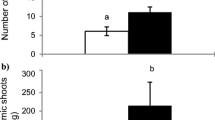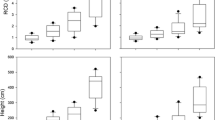Abstract
We examined the effect of early and intense pruning on light intensity under the canopy, individual growth, diameter–height relationships, and epicormic shoot dynamics in young hybrid larch (Larix gmelinii var. japonica × L. kaempferi) to establish a new effective management method for hybrid larch plantations. The objective is to produce high-quality wood while reducing silviculture costs using a combination of low-density planting and early and intense pruning. In a young hybrid larch plantation, we pruned branches to two different heights (2 and 4 m above ground level) using a no-pruning treatment as a control. Although the growth rates were lower in the heavy pruning treatment (4 m above the ground level) than in other treatments in the year following pruning, when measured 4 years later, growth did not differ between treatments. The number of epicormic shoots increased in the year following pruning, as did the relative photosynthetic photon flux density (rPPFD). The number of epicormic shoots was also dependent on the size of individual trees. However, survival of epicormic shoots was not sufficiently high to be problematic for high-quality timber production. If branches are pruned carefully such that the rPPFD does not rise above 20%, the emergence of epicormic shoots can also be controlled. Our results indicate that early and intense pruning is an effective component of a new management system for hybrid larch plantations.





Similar content being viewed by others
References
Asai T, Fukuchi M, Kikuzawa K, Mizutani E (1980) A study on pruning of Japanese larch (II) growth of the trees and sprouting of the epicormic shoots after pruning (in Japanese). Trans Jpn For Soc 91:245–246
Asai T, Fukuchi M, Kikuzawa K, Mizutani E (1981) A study on pruning of planted Sakhalin spruce (Picea glehnii Masters) (II) Growth of individuals after pruning (in Japanese). Trans Mtg Hokkaido Br Jpn For Soc 29:38–40
Asai T, Kikuzawa K, Fukuchi M, Mizutani E (1982) A study on pruning of planted Japanese larch (Larix leptolepis Gordon) (in Japanese). Bull Hokkaido For Res Inst 20:45–61
Bachelard EP (1969) Studies on the formation of epicormic shoots on eucalypt stem segments. Aust J Biol Sci 22:1291–1296
Bates D (2007) lme4: Linear mixed-effects models using S4 classes. R package version 0.99875-9
Bennett FA (1955) The effect of pruning on the height and diameter growth of planted Slash pine. J For 53:636–638
Briand CH, Daniel AD, Wilson KA, Woods HE (1998) Allometry of axis length, diameter, and taper in the devil’s walking stick (Aralia spinosa; Araliaceae). Am J Bot 85:1201–1206
Chiba S (1963) Study on the breeding of Larix (1). The differences of inter species for pests of wild rabbits or voles (in Japanese). Proc Hokkaido Branch Jpn For Soc 12:109–114
Cline MG (1996) Exogenous Auxin effects on lateral bud outgrowth in decapitated shoots. Ann Bot 78:255–266
Cline MG (1997) Concepts and terminology of apical dominance. Am J Bot 84:1064–1069
Department of Forestry, Hokkaido Government (1981) The guideline for management of thinning on larch forest. For the high quality wood production (in Japanese). Hokkaido Forestry Development and Extension Association, Sapporo
Fujimori T (1975) Study on the technical system of pruning. Bull Gov For Exp Station 273:1–74
Fujimoto S (1978) Studies on the shoot formation in Larix leptolepis Gordon (in Japanese). Res Bull Coll Exp For Hokkaido Univ 35:1–28
Fukuchi M, Kikuzawa K, Mizui N, Mizutani E (1982) Study on pruning of Todo fir (Abies sachalinensis Masters) (I). Effect of pruning intensity on the tree growth (in Japanese). Trans Mtg Hokkaido Br Jpn For Soc 30:36–38
Japan Meteorological Agency (2009) The Data base of Japanese meteorological statistically information (in Japanese) http://www.jma.go.jp/jma/menu/report.html
Johnson JB, Omland KS (2004) Model selection in ecology and evolution. Trends Ecol Evol 19:101–108
Kajihara M (1984) Studies on the relative stem-form and its application for estimating stem volume (VI) Relative stem-form and normal form-factors in even-aged stands of sugi (Cryptomeria japonica D.Don) with different density-controls (in Japanese). J Jpn For Soc 66:368–374
Kajihara M (1989) Changes of tapering grades in even-aged stand using a new definition and expression of a tapering grade (in Japanese). J Jpn For Soc 71:50–55
Kakihara M (1973) Consideration of pruning Larix leptolepis Gordon (in Japanese). Hoppo Ringyo (Northern Forestry, Japan) 25:336–338
Kaminaka S, Ogata N (1983) Relative light intensity in Hinoki (Chamaecyparis obtusa) stand (in Japanese). Bull For For Prod Res Inst 323:60–64
Kimball BA, Nolte DL, Griffin DL, Dutton SM, Ferguson S (1998) Impact of live canopy pruning on the chemical constituents of Douglas-fir vascular tissues: implications for black beer tree selection. For Ecol Manage 109:51–56
Koyama H (2001) Development of low-cost forestry management system by low-density planting—a case study of hybrid larch (in Japanese). Sanrin 1404:18–26
Koyama H, Asai T (1998) Validity of intense pruning on young-aged stand of Picea glehnii M. J Jpn For Soc 80:16–20
Kozlowski TT, Kramer PJ, Pallardy SG (1991) The physiological ecology of woody plants. Academic Press, London
Miyajima H (1981) III Regeneration 2. Artificial regeneration. In: Silviculture New Edition. Asakura, Tokyo, pp 116–129
O’Brien ST, Hubbell SP, Spiro P, Condit R, Foster RB (1995) Diameter, height, crown, and age relationships in eight neotropical tree species. Ecology 76:1926–1939
O’Hara KL, Valappil NI (2000) Epicormic sprouting of pruned western larch. Can J For Res 30:324–328
Oshima T, Nishikoori M (1994) Variation of stem crook in hybrid larch (Larix gmelinii var. japonica × L. leptolepis) (in Japanese). Trans Mtg Hokkaido Br Jpn For Soc 42:37–39
Pinheiro J, Bates D, DebRoy S, Sarkar D, the R Core team (2008) nlme: Linear and Nonlinear Mixed Effects Models. R package version 3.1-88
R Development Core Team (2007) R: A language and environment for statistical computing. R Foundation for Statistical Computing, Vienna, Austria. http://www.R-project.org
Shiraishi N (2005) Past, present and future of the system of yield prediction (monthly theme/systematic yield table) (in Japanese). Shinrin Gijutsu (For Technol) 764:9–12
Smith DM, Larson BC, Kelty MJ, Ashton PM (1997) The practice of silviculture applied forest ecology, 9th edn. Wiley, New York
Takeuchi I (2002) Studies on pruning for Knot-free timber production. Bull FFPRI 1:1–114
Takeuchi I, Hatiya K (1977) Effect of pruning on growth (I) A pruning experiment on mode stands of Cryptomeria japonica (in Japanese). J Jpn For Soc 59:313–320
Víquez E, Pérez D (2005) Effect of pruning on tree growth, yield, and wood properties of Tectona grandis plantations in Costa Rica. Silva Fenn 39:381–390
Ward WW (1966) Epicormic branching of black and white oaks. For Sci 12:290–296
Wignall TA, Browning G, MacKenzie KAD (1987) The physiology of epicormic bud emergence in Quercus robur L. responses to partial notch girdling in thinned and unthinned stands. Forestry 60:45–56
Yasaka M (2000) Development of low-cost silvicultural system planting in low-density (in Japanese). In: Seasonal Report of Larix Countermeasure Council in Hokkaido, vol 100, pp 1–10
Yokoi S, Yamaguchi K (1996) Origin of epicormic branches and effect of thinning on their development in Quercus mongolica var. grosseserrata. J Jpn For Soc 78:169–174
Acknowledgments
We thank members of the Silviculture Section, Hokkaido Forestry Research Institute, for help with the field measurements and laboratory work. Special thanks go to Seizaburo Izumi, Iwamizawa Park, for offering the use of his forest land as our study site. This study was partly supported by Grants-in-Aid from the Ministry of Education, Culture, Sports, Science, and Technology of Japan (No. 20380084 and 20370014).
Author information
Authors and Affiliations
Corresponding author
About this article
Cite this article
Takiya, M., Koyama, H., Umeki, K. et al. The effects of early and intense pruning on light penetration, tree growth, and epicormic shoot dynamics in a young hybrid larch stand. J For Res 15, 149–160 (2010). https://doi.org/10.1007/s10310-009-0167-z
Received:
Accepted:
Published:
Issue Date:
DOI: https://doi.org/10.1007/s10310-009-0167-z




